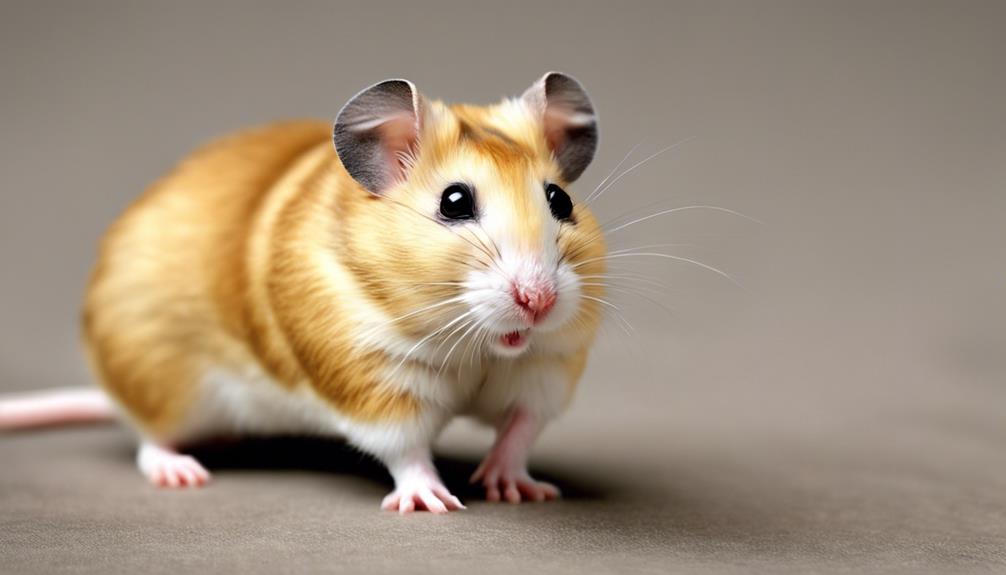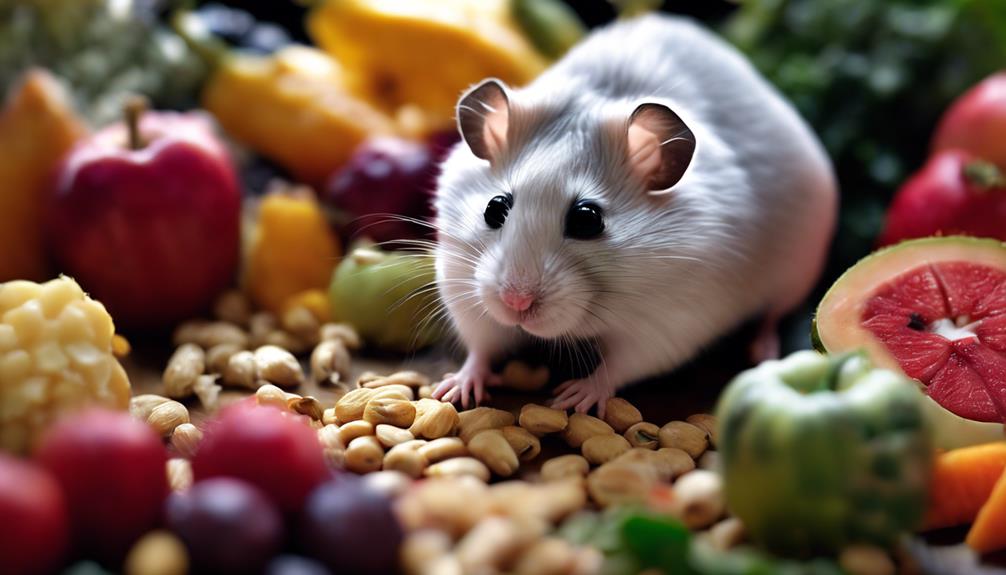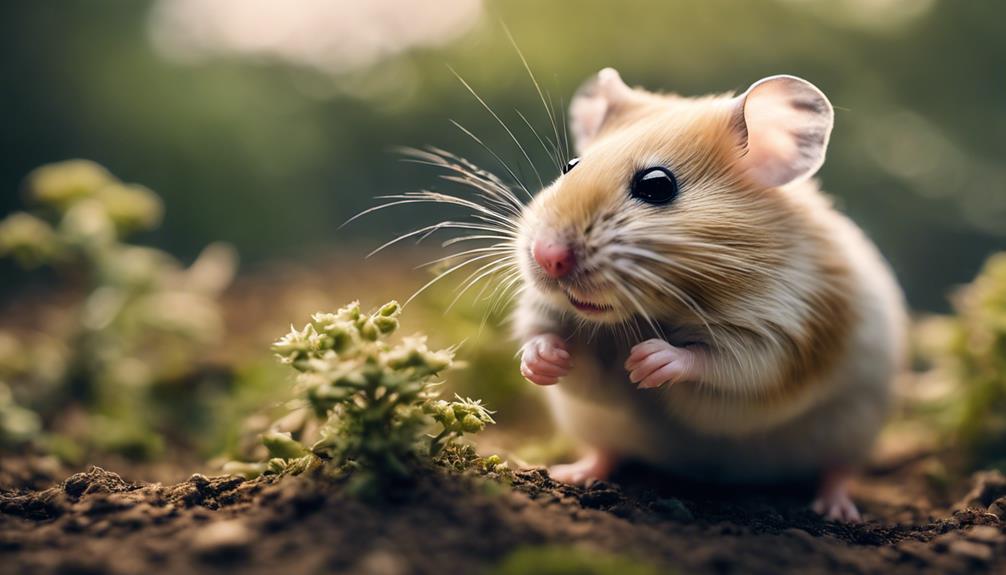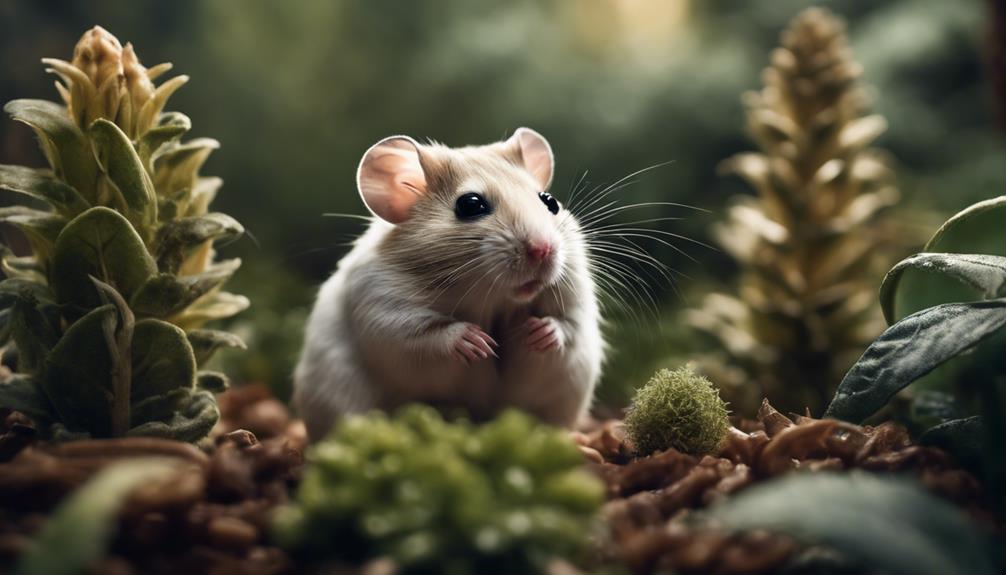What Makes the Chinese Hamster Unique?

The Chinese Hamster is unique due to its enigmatic behaviors and distinctive physical attributes, setting it apart from other hamster species.
Its presence in the animal kingdom showcases the subtle artistry of evolution, inviting fascination and curiosity.
Origin and History
Originating from the desolate plains of northern China, the Unique Chinese Hamster boasts a rich and intriguing history that intertwines with ancient folklore and modern scientific discovery. These hamsters have been revered in Chinese culture for centuries, with breeding practices carefully passed down through generations, highlighting their cultural significance. This careful breeding hasn't only preserved the species but also contributed to their genetic diversity, allowing them to adapt to various environments over their evolutionary history.
The Unique Chinese Hamster's genetic makeup holds clues to its ability to thrive in different conditions, showcasing the resilience and adaptability that have defined its existence. Through centuries of selective breeding, these hamsters haven't only become beloved pets but also valuable research subjects in the scientific community. Their evolutionary journey is a testament to the intricate balance between tradition and innovation, shedding light on the beauty of diversity and the power of adaptation.
Unique Physical Characteristics
The physical characteristics of the Chinese hamster are truly unique, setting it apart from other small rodents. Its size and fur exhibit a distinct charm, while its behavior and habits offer a glimpse into its fascinating nature.
Understanding its health needs and proper care is essential for ensuring a happy and healthy life for this extraordinary creature.
Size and Fur
With a compact size and soft fur that comes in various colors, the unique Chinese hamster captivates observers with its endearing physical characteristics.
Despite their small size, these hamsters boast a fluffy coat that's both charming and delightful to touch. Their fur can range from shades of brown to grey, and even white, adding to their allure.
The Chinese hamster's petite stature makes them easy to handle and care for, making them a popular choice among small pet enthusiasts. Their fur, which isn't only aesthetically pleasing but also serves as protection from harsh weather conditions, is a defining feature that sets them apart from other rodents.
In essence, the Chinese hamster's size and fur contribute to their overall appeal and uniqueness.
Behavior and Habits
Beholding the unique Chinese hamster in its natural habitat unveils a tapestry of behaviors and habits that showcase its distinctive physical characteristics. These charming creatures are known for their intricate social interactions, often engaging in grooming rituals that strengthen bonds within their groups. When it comes to nesting, Chinese hamsters exhibit remarkable architectural skills, constructing elaborate burrows using bedding materials meticulously gathered with tiny paws. In terms of activity levels, these hamsters are surprisingly energetic, scurrying around their environment with agility and grace. Their communication is subtle yet effective, using a combination of soft squeaks and body language to convey messages to one another. The Chinese hamster's behavior is a testament to its intelligence and adaptability.
| Social Interactions | Nesting |
|---|---|
| Grooming rituals | Elaborate burrows |
| Strengthening bonds | Meticulous builders |
Health and Care
Unveiling the unique Chinese hamster's health and care requirements reveals a set of distinctive physical characteristics that demand specific attention and nurturing. These charming creatures have specific needs that contribute to their overall well-being and happiness:
- Exercise Requirements: Chinese hamsters are active little beings that require ample opportunities to exercise. Providing them with a spacious cage and engaging toys can help keep them healthy and mentally stimulated.
- Health Concerns: Due to their small size, Chinese hamsters are susceptible to health issues such as diabetes and dental problems. Regular veterinary check-ups and a balanced diet are essential for their well-being.
- Grooming Needs, Enrichment Activities: Regular grooming, such as providing a dust bath, and enrichment activities like hiding treats for them to find, are crucial for keeping these unique pets content and thriving.
Behavior and Personality Traits
Revealing its complex nature, the Unique Chinese Hamster exhibits distinctive behavior and personality traits that captivate observers. Known for their playful and curious behavior, these small creatures enjoy exploring their surroundings with boundless energy. Chinese Hamsters are social animals that engage in intricate social interactions and communication within their groups. They establish hierarchies through subtle cues, such as grooming and scent marking, to maintain harmony within their community.
Despite their diminutive size, Chinese Hamsters display a remarkable level of intelligence and problem-solving skills. They're quick learners and can adapt to various stimuli in their environment. Additionally, these hamsters are known for their nocturnal habits, often becoming more active during the night.
When kept as pets, Chinese Hamsters form strong bonds with their owners, showing affection through gentle nibbling and grooming. Their inquisitive nature and charming personalities make them delightful companions for those seeking a small yet engaging pet.
Dietary Needs and Preferences

The dietary needs and preferences of the Unique Chinese Hamster are essential aspects to consider for optimal care and health maintenance. These small creatures have specific requirements that contribute to their overall well-being and vitality:
- Food preferences: Chinese hamsters are omnivores, enjoying a diet that includes a variety of seeds, grains, fruits, and vegetables. Providing a balanced mix ensures they receive the necessary nutrients for a healthy life.
- Nutritional needs: High-quality hamster pellets are a staple in their diet, offering essential vitamins and minerals. Supplementing with fresh foods such as leafy greens and occasional protein sources like mealworms can further enhance their nutrition.
- Eating habits: Chinese hamsters are known to hoard food in their nests, so offering a consistent supply of food is important. They're also prone to overeating, so portion control is necessary to prevent obesity and related health issues.
Understanding and meeting the dietary requirements of the Unique Chinese Hamster is crucial for fostering a thriving and content companion.
Reproduction and Life Cycle
In the intricate tapestry of life for the Unique Chinese Hamster, the journey of reproduction and the cycle of existence unfold with delicate precision. This fascinating creature exhibits unique breeding habits, with females usually coming into estrus every four days, making them polyestrous. The reproductive cycle of the Chinese Hamster is intriguing, with a gestation period ranging from 18 to 22 days before giving birth to a litter of about 4 to 12 pups. These tiny offspring are born hairless and blind, relying completely on their mother for warmth, nourishment, and protection.
The Chinese Hamster, despite its small size, showcases remarkable longevity, with a lifespan that can extend up to three years in captivity. This longevity, coupled with their reproductive capabilities, allows these hamsters to contribute significantly to their population. As they navigate through the intricate dance of life, the Unique Chinese Hamsters exemplify the beauty and wonder of existence through their reproduction and life cycle.
Habitat and Environmental Adaptations

The Chinese hamster, with its unique adaptations, thrives in its natural habitat, showcasing remarkable resilience to environmental challenges.
Its specific habitat details and observed adaptations shed light on the creature's ability to survive and thrive in various conditions.
Understanding these nuances provides valuable insights into the Chinese hamster's evolutionary journey and its remarkable ability to adapt to diverse environments.
Natural Habitat Specifics
Elegantly adapted to its natural surroundings, the unique Chinese hamster thrives in diverse habitats with remarkable environmental resilience.
- Burrow digging, nesting: Chinese hamsters are adept at excavating intricate burrows for shelter and nesting. Their underground homes provide protection from predators and harsh weather conditions.
- Foraging, exploring: With an innate curiosity, Chinese hamsters actively forage for food, using their keen sense of smell and sharp eyesight to explore their surroundings. This behavior contributes to their survival in the wild.
- Adaptable diet: Chinese hamsters have a flexible diet, consuming a variety of seeds, grains, fruits, and insects found in their habitat. This adaptability allows them to thrive in different ecosystems with varying food sources.
Unique Adaptations Observed
Demonstrating remarkable adaptability to their environment, Chinese hamsters showcase unique habitat and environmental adaptations that contribute to their survival in diverse ecosystems.
Their nesting behaviors are finely tuned to provide shelter and security, often utilizing intricate tunnel systems to evade predators and harsh weather conditions. These survival strategies have been honed over generations, providing the Chinese hamster with evolutionary advantages that are reflected in their genetic traits.
Their ability to efficiently utilize resources and adapt to varying environmental challenges underscores their resilience. By understanding and appreciating these unique adaptations, we gain insight into the intricate balance between nature and nurture that shapes the Chinese hamster's existence in the ever-changing tapestry of the natural world.
Chinese Hamster as a Pet
In the world of small pets, the Chinese Hamster stands out for its unique charm and low maintenance nature, making it an appealing choice for those seeking a delightful companion. Chinese Hamsters can make wonderful pets when provided with proper care and attention.
- Training Techniques and Socialization: Chinese Hamsters are intelligent creatures that can be trained to a certain extent. They can learn to recognize their owners and even some simple tricks with patience and positive reinforcement. Socializing your hamster from a young age can help them become comfortable with human interaction.
- Exercise Requirements and Enrichment Activities: These active little hamsters require plenty of exercise to stay healthy and happy. Providing them with a wheel for running is essential, along with a spacious cage for exploration. Enrichment activities like hiding treats for them to find or introducing new toys can keep them mentally stimulated.
Chinese Hamsters can bring joy and companionship to those willing to invest time in understanding their needs and behaviors.
Conservation and Protection Status

The conservation and protection status of the Chinese Hamster warrants careful attention given its significance in preserving biodiversity. Conservation efforts play a crucial role in safeguarding this unique species from the threats it faces. Population trends indicate a concerning decline, primarily due to habitat loss caused by human activities. As urbanization and agricultural expansion encroach upon the hamster's natural habitats, protective laws become essential to ensure its survival.
To counteract the negative impacts of habitat loss, conservation initiatives must be implemented to secure the Chinese Hamster's future. By raising awareness about the importance of preserving this species and enforcing stringent protection laws, we can take significant steps towards mitigating the risks it encounters. The Chinese Hamster's intrinsic value lies not only in its distinct characteristics but also in its contribution to the intricate tapestry of biodiversity. Thus, prioritizing conservation efforts and advocating for its protection are imperative in upholding the delicate balance of our ecosystems.
Frequently Asked Questions
Are Chinese Hamsters Prone to Any Specific Health Issues or Diseases?
Chinese hamsters are generally healthy but may have genetic predispositions to common illnesses like diabetes or respiratory issues. Regular vet check-ups, a balanced diet, and a clean living environment are crucial for preventive care and health maintenance.
How Long Do Chinese Hamsters Typically Live in Captivity?
In the realm of captivity, the lifespan of Chinese hamsters dances like a flickering flame, influenced by genetic whims and the nourishing touch of environment and diet. Their time here varies, a delicate balance.
Can Chinese Hamsters Be Trained to Do Tricks or Respond to Commands?
Chinese hamsters possess limited training potential. While they can learn basic tricks and respond to simple commands, their independent nature and small size present challenges. Their behavioral responses vary, requiring patience and understanding from handlers.
Do Chinese Hamsters Have Any Unique Vocalizations or Communication Methods?
Chinese hamsters have unique vocalizations and communication methods. They use a variety of sounds and body language to convey emotions and needs. Observing their social interactions reveals a rich tapestry of non-verbal cues that are fascinating to decipher.
Are There Any Specific Toys or Enrichment Activities That Are Recommended for Chinese Hamsters?
For Chinese hamsters, it's vital to provide exercise wheels and tunnels for physical activity. Chew toys and hiding spots offer mental stimulation. These enrichments promote their well-being, ensuring a happy and healthy hamster life.









